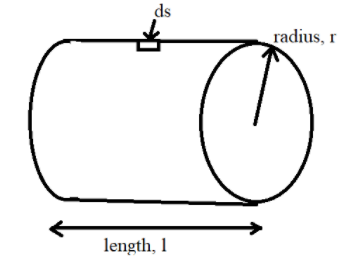Question
Question: Electric intensity outside a charged cylinder having the charge per unit length \(\lambda \) at a di...
Electric intensity outside a charged cylinder having the charge per unit length λ at a distance r from its axis is
A. E=kr22πε0λ
B. E=2πkr2ε0λ
C. E=2πε0krλ
D. E=kr24πε0λ
Solution
The electric intensity outside the charged cylinder having dimension as per given is calculated by placing a charge outside the cylinder. And by using the Gauss’s theorem, the relation between the charge and the total normal electric intensity is derived.

Useful formula:
Gauss’s theorem states that Total normal electric induction over any closed surface is equal to the total charge enclosed by that surface.
q=TNEI
Where, q is the charge enclosed by the surface, TNEI is the Total normal electric induction.
The total normal electric induction over any closed surface is given by,
TNEI=∫εEcosθds
Where, εis the permittivity of medium, Eis the electric field intensity, θ is the angle between area vector and electric field and ds is the small area enclosed.
Complete step by step answer:
Given, The charge per unit length is λ,
The radius of the cylinder is r.
When a charge q is placed in a free space, it creates some region around itself in which other charge gets attraction or repulsion. This is known as the electric field. Consider an imaginary closed surface area in which the charge q is located then the tubes of induction pass through the area. The total number of tubes of forces passing normally through the whole area is known as total normal electric induction (TNEI).
The total normal electric induction over any closed surface is given by,
TNEI=∫εEcosθds............................(1)
The charges are uniform in the conduction cylinder. So, there is a symmetry around the imaginary surface. Hence E is constant. The values of permittivity of mediumε and the angle θ is Zero. Then,
TNEI=εEcos0∫ds
Since cos0=1 so,
TNEI=εE∫ds
The area of the cylinder is given by ∫ds=2πrl
Where, ris the radius of the cylinder, l is the length of the cylinder.
TNEI=εE×2πrl
The charge enclosed by the surface is defined by,
q=λl......................................(2)
By Gauss’s theorem,
q=TNEI
Substitute the value of TNEIand q values in above equation,
λl=εE×2πrl 2πrlελl=E E=2πεrλ
Since, ε=ε0k
Where, ε0is the permittivity of free space, ε is the permittivity of medium and k is the proportionality constant.
Substituting the εvalue in above equation,
E=2πε0krλ
Hence, the option (C) is correct.
Note:
Since, the charge outside the charged cylinder is equal to the total normal electric field intensity of the charged cylinder, using this relation the value of electric field intensity is calculated. The electric field intensity is completely dependent on the charge per unit length of the cylinder, the permittivity of the medium and the radius of the cylinder.
